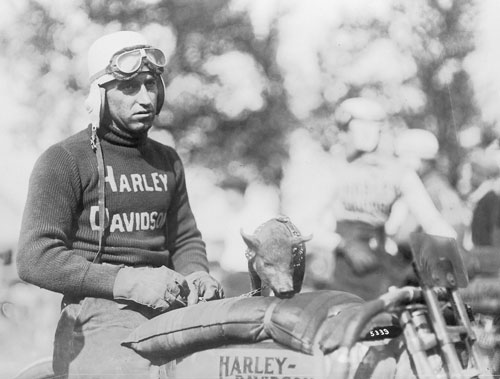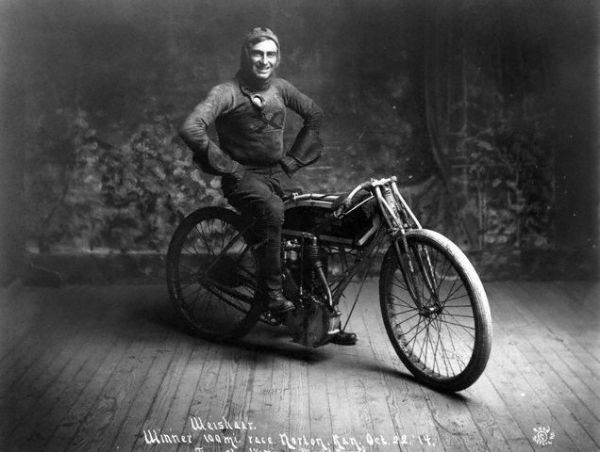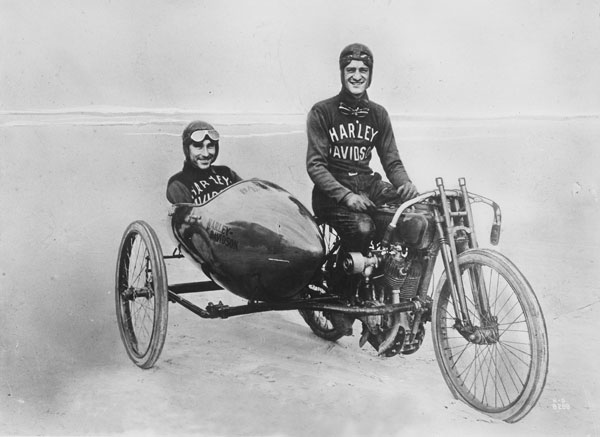Harley-Davidson "Hog Boys" racer Ray Weishaar taking good care of the team mascot.
The term “HOG” has been affectionately associated with Harley-Davidson for decades. It’s a workhorse term for the iconic motorcycle company that serves many purposes. Harley-Davidson is identified as HOG on the NYSE, they coined H.O.G. as an acronym for “Harley Owners Group”, and Harley-Davidson even attempted to trademark “HOG” IN 1999– and lost when it was ruled that “HOG” had become a common generic term used for large motorcycles, and therefore was unprotect-able as a trademark.
All that said, the ones originally responsible for the “HOG” handle were a roughneck group of farm boys that rode for the H-D racing team back in the 1910s-1920s who’d take their little pig mascot on a victory lap after every race their team won– giving them the name “Hog Boys.” They deserve a great deal of respect– more than one paid the ultimate price and left it all on the track for the sport that was their life– racing motorcycles. These guys also had their careers interrupted by our great country’s call to serve in WWI. More than likely, many of us today cannot begin to fathom the depth of their personal commitment and sacrifices.
**
Ray Weishaar was undoubtedly one of the best known and popular motorcycle racing stars of the 1910s and 1920s. He rode the board and dirt tracks of the country for the Harley-Davidson factory racing team. Weishaar is seen here with the famous team Harley "hog" mascot on the tank of his bike.
Ray Weishaar was coined the “Kansas Cyclone”– dominating the county fair circuits of Kansas from 1908 to 1910. He was a dominant racer– the Kansas State Championship two years in a row. His second win came even with his handlebars breaking halfway off– although he won the race, he didn’t break his previous year’s record. Ray Weishaar became part of the Harley-Davidson factory racing team in 1916, finishing third at Dodge City that year and winning the FAM 100-Mile Championship in Detroit. Weishaar was also offered a Harley-Davidson dealership and became a dealer for three years. Weishaar was by no means finished with racing though, and returned to the competitive circuit in 1919.
*
One fateful race, Weishaar was battling Gene Walker for the lead– Johnny Seymour drafted past them both, sending Weishaar’s bike into a high-speed wobble. The bike went into a skid and Weishaar fought hard to save it before hitting the outside fence. Weishaar went through the wooden fence and incredibly was still conscious. He was not thought to be seriously injured in the crash. His wife, Emma, drove him to Los Angeles General Hospital where he tragically died just a few hours later from internal injuries. The motorcycle racing community rallied to support Weishaar’s surviving wife and six-month-old son and generously paid off the mortgage on the family’s home.
*
Leslie "Red" Parkhurst with fellow Harley-Davidson racer Fred Ludlow in the sidecar. "Red" has a sight to be seen, standing 6' 4" and topped with a mop of shocking red hair. He was also good friends with another sports celebrity and fellow Coloradoan-- Jack Dempsey.
*Harley-Davidson’s very first factory racer, Leslie “Red” Parkhurst, was somewhat of a celebrity among racing enthusiasts in those days– breaking 23 speed records and winning a slew of top national races for Harley from 1914-1920. He had a brief and unsuccessful stint at Excelsior in 1921, and quickly returned to Harley in 1922 to race for them again. By this time Parkhurst had a family, and his racing career slowed down considerably, with him competing only in select events. “Red” Parkhurst transitioned into a successful sales career for Firestone and Valvoline. He retired in the 1960s and died in 1972 while living in Washington State at 76 years old.
The Selvedge Yard
More to come...





No comments:
Post a Comment